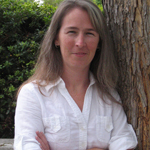Monkey see, monkey do

Monkey see, monkey do
- August 1, 2007
- Using fMRI, cognitive scientist Emily Grossman studies how we learn by observing actions of others; findings help researchers understand how brain areas communicate with one another, helps treat those with brain abnormalities
 If you want to be a better golfer, you study, among other things, a successful golfer.
You watch their swing, how they hold their club, how they position their feet. Essentially,
you study how they expertly perform the action you yourself intend to master; common
knowledge with which Emily Grossman, cognitive science professor and associate director
of the Center of Cognitive Neuroscience at UC Irvine, agrees.
If you want to be a better golfer, you study, among other things, a successful golfer.
You watch their swing, how they hold their club, how they position their feet. Essentially,
you study how they expertly perform the action you yourself intend to master; common
knowledge with which Emily Grossman, cognitive science professor and associate director
of the Center of Cognitive Neuroscience at UC Irvine, agrees.
"People are able to generate motor activities very effectively when viewing similar
motor activities," she says, hence the proverbial 'monkey see, monkey do.' This, however,
is not always the case in certain populations, says Grossman, noting that individuals
suffering from autism, schizophrenia and stroke experience varying levels of difficulty
when attempting to emulate similarly represented actions. This difficulty stems, in
part, from abnormalities or dysfunctions in an area of the brain with which Grossman
is very familiar.
"The superior temporal sulcus is an area of the brain associated with visual perception
of biological motion," she says. "When we observe someone performing an action - walking,
throwing, kicking - this part of the brain becomes very active." Discovering this
phenomenon while in graduate school, Grossman employs MRI technology to study brain
activity levels in the superior temporal sulcus in order to better understand how
visual and motor activities come together to formulate perception. "In a normally
functioning brain, this construction happens almost instantaneously," she says. It
makes sense, then, that when this area is damaged or doesn't form properly, perception
becomes more difficult as is often the case for victims of stroke and individuals
with autism and schizophrenia, respectively.
Through continued research, Grossman seeks to further understand how the many different
areas of the brain communicate. "There are well over 30 areas in our brain dedicated
to vision, of which there are only three to four where we have a good idea of what's
happening. The rest is unknown," Grossman says. "My interest is to better understand
how these areas talk to one another to contribute to our awareness."
Share on:
Related News Items
- Dickson receives grant to apply computational cognitive models to language acquisition
- Three from social sciences among 21 to be honored at annual UC Irvine Lauds and Laurel event
- Bipartisan immigration reform package? Some California lawmakers back it, but will Congress pass it?
- Immigrants in Europe and North America earn 18% less than natives - here's why
- Expert finds access to high-paying jobs - not unequal pay for the same job - is the biggest driver of immigrant wage gaps

